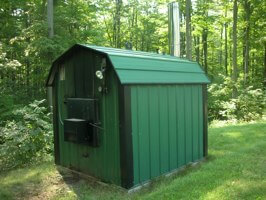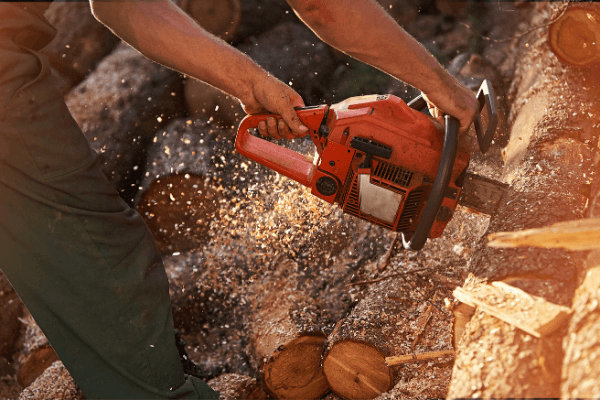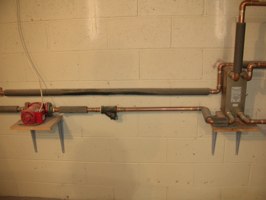- Home
- Heating With Wood
- Outdoor Wood Furnace
Outdoor Wood Furnace
This post may contain affiliate links so I earn a commission.
Although the initial investment can be high, an outdoor wood furnace can eliminate your monthly heating bill.
Heating with firewood can be very enjoyable, but after sweeping your floor 3 times a day and filling the wood stove with firewood every 4 hours, you may be searching for an easier option.
Have you always wanted a system that could effectively heat your entire house without the hassle of adding firewood in the middle of the night?
Do you dread the thought of hauling firewood into your house, leaving wood chips and dirt everywhere?
If this sounds appealing than this option might be a perfect choice.
How Does An Outdoor Wood Furnace Work?
An outdoor wood furnace is installed outside your home, roughly 50-150 feet away.
The distance really just depends on your specific situation, but you'll need to consider the cost and labor of burying the underground tubing as well as heat loss during extended runs.
Although the tubing is insulated, you'll loose a little bit of heat from the water as it's circulated between the furnace and the heat exchanger.
So, the further it is from your house the more heat you'll loose, but it's not a huge amount.
As you're considering installation options, remember these units are very large so you'll have to pour a cement pad for it to sit on.

The components are pretty simple, it's a firebox surrounded by a water jacket.
The fire heats the water to a specific temperature (usually 180 degrees) which is automatically controlled by the unit through an aquastat.
The aquastat is a device on the boiler that safely controls the water temperature at a set temperature.
When the temperature is too low, the stove opens up the air supply feeding air to the fire to raise the temperature.
Once the set temperature is reached, the aquastat closes the air supply which dampers down the fire and reduces the temperature.
The heated water is pumped into your house through underground tubing using a circulation pump.
The tubing connects to a heat exchanger where the heat is transferred to your existing heating equipment.
The heated water inside the wood furnace never mixes with your existing heating unit or domestic water.
All of the heat is transferred through the heat exchanger.
Benefits Of Having It Outside
There's a couple of really good benefits to owning an outdoor wood furnace as opposed to heating with a wood stove.
Since the furnace is outside, you never have to worry about hauling firewood inside your home, reducing the mess and the possibility of bringing insects inside.
They're also capable of burning large pieces of wood at various lengths.
This really reduces the amount of time you spend cutting firewood.
Since the sizing doesn't need to be exact, you can throw just about any size log you want into the firebox.

Depending on the outside temperature, the firebox is filled once or twice a day eliminating the need to constantly check the fire.
The temperature in the house is still controlled by the existing thermostat controls.
The household heating system functions just like it normally would, the only difference is you're burning wood, not an expensive alternative fuel like propane.
A wood furnace is also capable of heating an additional building or item.
Most units have two outlets on the back. One to heat your home and another to heat an item of your choice.
If you only need to heat your home you can simply close the other outlet off.
The two outlets give you the option of heating a nearby barn, pool or hot tub.
The photo below shows the red circulation pump that is pumping the heated water through the heat exchanger.
The water to my homes baseboard heat also passes through the heat exchanger where the heat transfer takes place.
So basically, all of the water that runs through my homes baseboard heating system is heated by the heat exchanger.

Heating your domestic hot water is also handled by the wood furnace.
Just connect the line to another heat exchanger which will transfer the heat to your hot water tank.
We currently use a sidearm heat exchanger to heat our domestic hot water.
The sidearm heat exchanger uses a thermosiphon process to heat the water inside your hot water heater.
Again, the two water sources never mix, the heat exchanger takes care of all of the work.
Sidearm heat exchangers work pretty well for heating your hot water, but the thermosiphon process can be a little temperamental and the installation has to be really accurate.
If you're having difficulties with getting the sidearm heat exchanger to work, check out this article that will give solutions to why your sidearm heat exchanger is not working.
The sidearm heat exchanger when working properly supplies 100 percent of our hot water and our electric hot water heater is completely turned off!
Buying An Outdoor Wood Furnace?
Over the last 10 years wood boilers have become very popular and they are now manufactured by a variety of different companies.
The initial cost can be expensive, ranging on average from about $5000-$7000.
Some units can be more or less.
Depending on your current heating costs, this may take several years to recover your initial investment.
Overall, heating with an outdoor wood furnace can supply your house with consistent heat for many years without the need to constantly tend to your fire.

About the Author
Obsessed with firewood, Nick is behind over 350+ of Firewood For Life's articles, as well as countless reviews, guides and YouTube videos to help readers like you reduce heating costs and create the perfect fire.


